Boot Device Not Found: How to Fix a No Bootable Devices Found Error
PAGE CONTENT:
- Method 1. Check Your BIOS Settings and Boot Order
- Method 2. Reset Primary Partition as Active
- Method 3. Check Internal Hard Disk Status
- Method 4. Check and Repair Hard Disk Partition Errors with Qiling Partition Master
- Method 5. Create Windows Bootable Media
You're in the middle of a crucial task, whether it's a work deadline, school project, or some much-needed retail therapy, when your computer suddenly informs you of an error message upon startup. It's as if the universe is conspiring against you, and this usually happens at the most inopportune moment, leaving you frustrated and wondering what could have been done to prevent it.
Startup errors can be frustrating, but they're often due to simple issues like a misplaced boot device or incorrect setup. A quick tweak can resolve the problem. However, some errors can be more serious, requiring a more in-depth solution. In either case, identifying the root cause is key to resolving the issue.
A boot drive error can be frustrating, but it doesn't necessarily mean your computer is compromised or your hard drive is erased. It simply means you won't be able to use your computer until the issue is resolved.
A boot drive error occurs when your computer is unable to access the boot drive, which is typically the hard drive or solid-state drive (SSD) that contains the operating system and essential files. This error can be caused by a variety of factors, such as a faulty hard drive, a corrupted boot sector, or a mismatch between the boot drive and the BIOS settings. In some cases, you may be able to resolve the issue on your own by checking the BIOS settings, running a disk check, or reinstalling the operating system. However, if the problem persists, it may be necessary to seek the assistance of a professional to diagnose and repair the issue.
What's the Cause of No Bootable Devices Found Error?
The "no bootable devices found" issue occurs when your computer can't locate a boot sector, but we'll dive deeper to understand the "boot device not found" problem. This starting error typically happens without issue when you restart your computer, but it can occur when your system can't find a bootable device to initiate the boot process.
A boot device is storage hardware, such as a hard disc drive or solid-state drive, or a partition on your storage device, that identifies itself as a bootable storage device to your laptop/BIOS computer's firmware, defining itself as a bootable device in one of two ways.
- The bootable storage device identifies itself as a "handshake" in the BIOS, allowing the motherboard to examine its hardware identity, which includes information like manufacturers, model, and storage capacity, effectively integrating the system board with the hard disc or flash drive.
- The motherboard prioritizes storage devices connected to the PC, creating a boot sequence or order. The first device identified as a boot device will be used to boot the computer. The motherboard then locates the device's boot sectors and master boot record (MBR), and the MBR boots Windows.
The computer determines which MBR boot device to use based on a list, attempting to boot from the first one. If it can't, it may display a "no boot device found" error message.
To repair the "boot device not found" issue, we can try to fix the boot order in the BIOS settings, or reinstall the operating system, or use a bootable USB drive to repair the boot sector. We can also try to replace the faulty hard drive or SSD with a new one. Additionally, we can run a disk check and a disk cleanup to ensure the hard drive or SSD is clean and free from errors.
How to Fix No Bootable Devices Found
If you're experiencing the frustrating "no bootable device found" error, don't worry! We've got you covered. Below, we've listed methods to quickly resolve this issue, so you can get back to your day without any further delay.
Method 1. Check Your BIOS Settings and Boot Order
An improper boot sequence can cause your computer to boot from an unbootable hard disk, resulting in the "no bootable devices found" error message, so make sure your system hard disk is in the first position in the boot order.
To do so, follow the steps outlined below:
Step 1. First, "Reboot" your PC and then press (Del/F2/F10…) to enter into BIOS mode.
Step 2. To configure your system's boot order, use the right arrow keys to navigate to the "Boot" tab, and then position your system hard drive at the top of the boot order list.
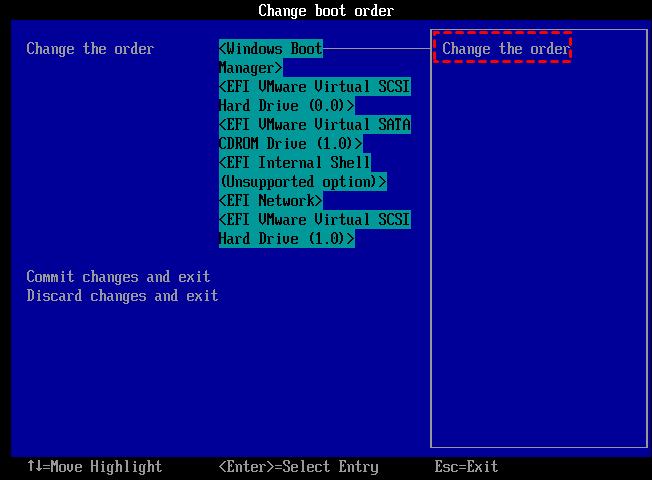
Method 2. Reset Primary Partition as Active
The primary partition is the one on which the operating system is installed. It must be set to active in order for the OS to boot successfully. If it is accidentally turned inactive, the "no boot device found" error will be triggered. To resolve this, simply reactivate it. This can be done by accessing the BIOS settings, selecting the primary partition as the active one, and saving the changes. This should resolve the issue and allow the computer to boot normally.
Step 1. Start your computer by inserting the Windows installation DVD. Choose your language and keyboard layout, then click "Repair your computer."
Step 2. If you have a Windows installation DVD, select "Troubleshoot" and then "Command Prompt." If using a Windows 7 DVD, choose the first option and proceed to the "Command Prompt" window.
Step 3. Write the below-mentioned commands in the elevated Command Prompt window one at a time, then click "Enter."
- list disk
- Select disk 0 (0 is the disk number of the system hard disk.)
- list partition
- Select partition 1 (1 represents the number of your system partition.)
- active
Method 3. Check Internal Hard Disk Status
To fix the "no bootable device found" error, run the CHKDSK utility in the Command Prompt to check the internal hard drive for any disc problems. To do this, open the Command Prompt, then type "chkdsk c: /f /x /r" and press enter, which will scan the C drive for issues and attempt to repair them if possible.
The CHKDSK command is a utility that checks and repairs disk errors, but it may cause permanent data loss. If you value your data, it's recommended to use alternative methods for fixing disk issues.
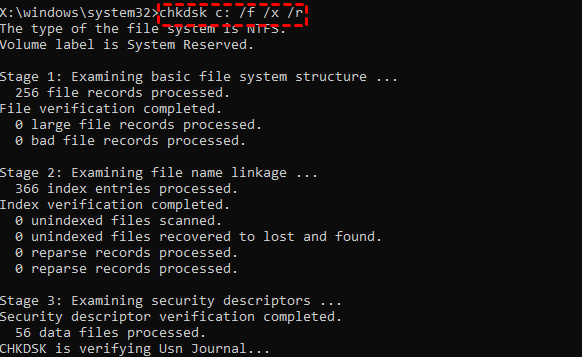
Method 4. Check and Repair Hard Disk Partition Errors with Qiling Partition Master
Qiling Partition Master offers a simple solution to check and fix partition errors in Windows 10, 8, or other Windows OS with a one-click process. To do this, download and start the Qiling partition management software, locate the hard disk, and then run the check file system.
Qiling Partition Master can analyze hard drive errors and automatically run repairs. To use this feature, the software will analyze and fix hard drive errors, and can also be used to repair USB drive errors or hard drive errors on different Windows systems.
Step 1. Choose "Fix boot" in the "Tools and utilities" page to start.
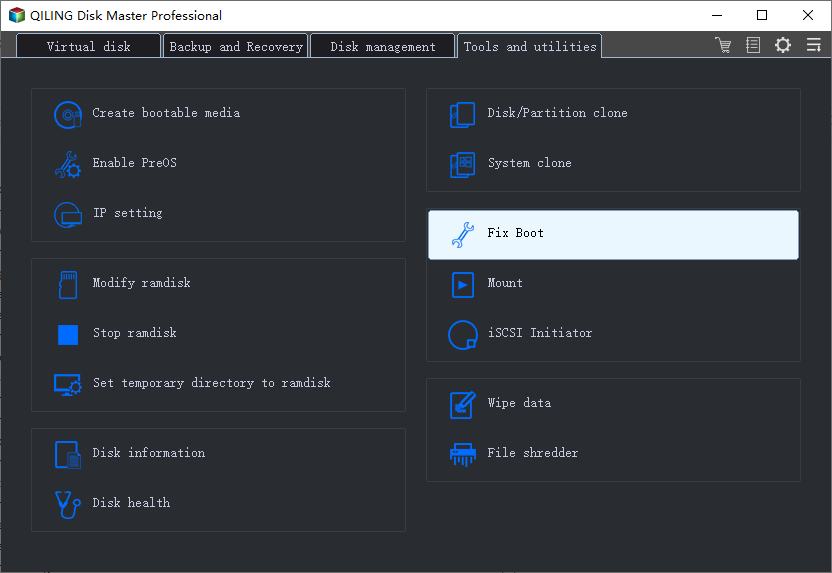
Step 2. Select the HDD that you want to fix. Click "Proceed" to continue.
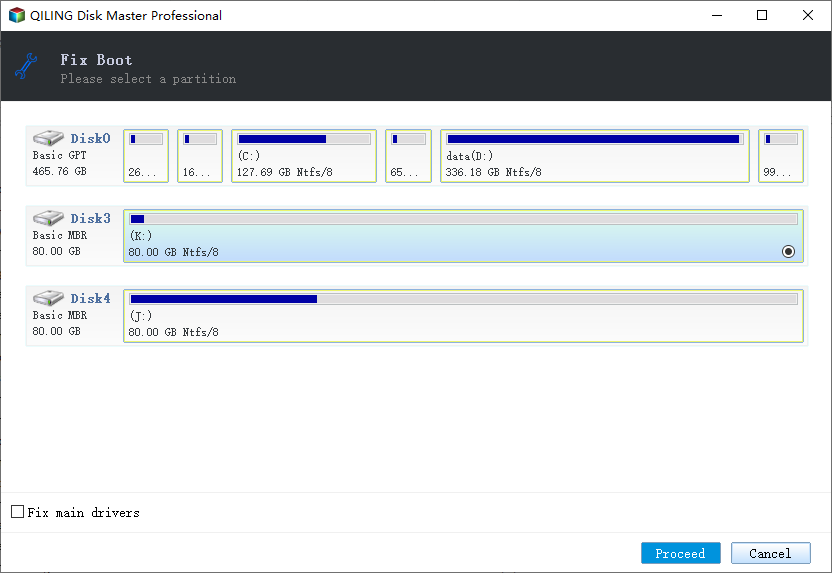
Method 5. Create Windows Bootable Media with Qiling Partition Master
The need to create a bootable partition manager that can resize partitions is a common inquiry on partition manager forums. This guide will walk you through the process of creating a bootable USB drive partition manager using Qiling Partition Master.
Qiling Partition Master is a powerful partition manager for both 32-bit and 64-bit Windows operating systems, allowing users to safely manage hard disc partitions from a bootable USB device.
Qiling Partition Master can also partition external hard drives aside from hard discs and RAID.
Step 1. To create a bootable disk of Qiling Partition Master, prepare a storage media such as a USB drive or CD/DVD disc, and connect it to your computer.
Step 2. Launch Qiling Partition Master, find the "Create bootable media" feature in tools page and click on it.
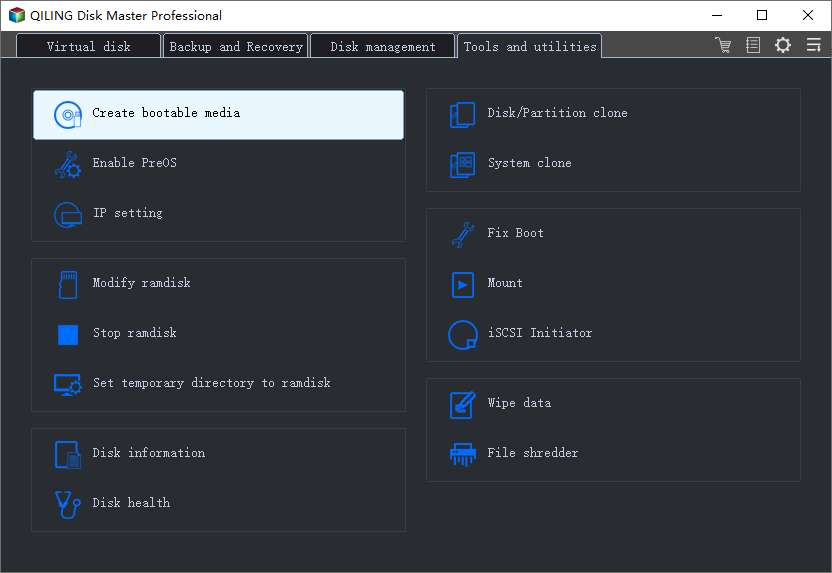
Step 3. Choose USB or CD/DVD according to the device you connect to the computer, then click "Proceed".
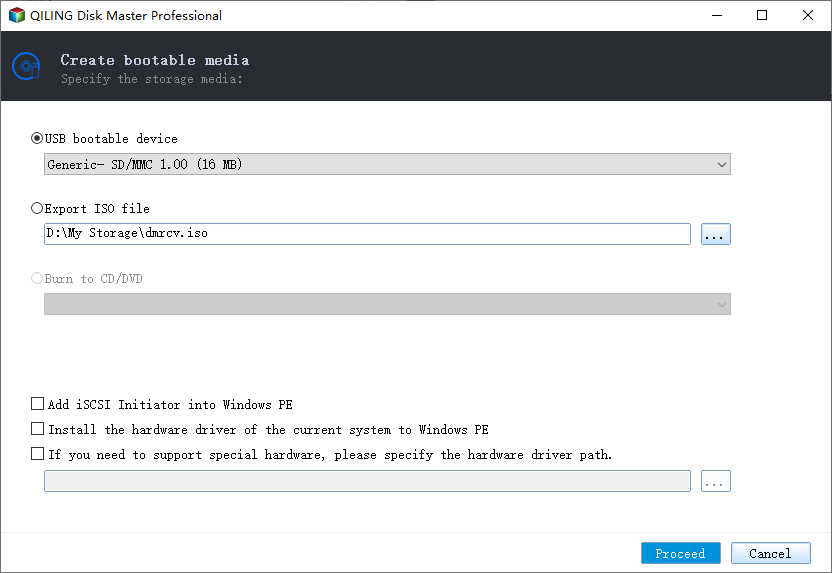
Once the process is complete, you'll have a Qiling Partition Master WinPE bootable disk that allows you to manage your hard disks and partitions even when your computer fails to boot normally.
To load the RAID driver, click "Add Driver" from the menu bar, which allows you to add the driver for your device under the WinPE environment. This is necessary for devices like RAID or specific hard drives that may not be recognized without the correct drivers installed.
More to Know: What Does No Bootable Devices Found Mean?
The "boot device not found" error occurs when a computer can't identify a bootable disk, typically requiring a boot device like a hard drive or SSD. This error is often met with a black screen and a command prompt instead of the usual Windows startup. The issue is usually caused by a problem with the computer's motherboard, and may specifically appear as a 3f0 error on HP laptops and PCs.
The BIOS contains the boot sequence for your laptop or desktop computer, which often lists the system drive as the first boot device. It also includes the hardware address of the hard disk and the instructions to access the hard drive's master boot record or boot sector, which stores the operating system's starting location. This is read when you boot up Windows, and some variations of the warning message read "boot device not detected; please install an operating system."
If the BIOS can't find a bootable hard drive, it can't locate the Master Boot Record (MBR) or boot sector, so it tries all possible boot configurations. If none of them work, it displays the message.
A bootable device can be any storage attached to your computer, such as a USB, CD/DVD, or HDD/SSD/NVMe, or even a network or remote repository for more advanced users.
Conclusion
If your computer is malfunctioning due to a Windows boot device not detected issue, don't worry! You can resolve the problem using the effective methods highlighted in this article. Alternatively, you can use Qiling Partition Master to quickly fix the error.
Related Articles
- [Fixed] 'Current Read-Only State Yes' on USB Flash Drive/SD Card
- How to Convert GPT to MBR Without Operating System
- How Do I Use DiskPart to Delete All Partitions in Windows? Your 2021 Guide Is Here
- Partition Manager for Windows 11 Free Download in 2021
- Access GPT Protective Partition Without Losing Data
- Windows 11 System Migration Software: Free/Paid Software to Move OS to SSD